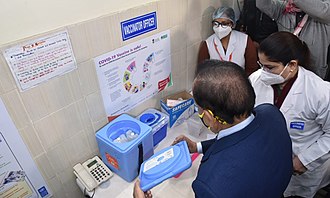COVID-19 pandemic in Chandigarh
Overview of the COVID-19 pandemic in Chandigarh
The COVID-19 pandemic in Chandigarh is part of the worldwide pandemic of coronavirus disease 2019 (COVID-19) caused by severe acute respiratory syndrome coronavirus 2 (SARS-CoV-2). The first case in Chandigarh was reported on 19 March 2020. Since then, the city has experienced multiple waves of infections, with varying impacts on public health and the local economy.
Background[edit]
Chandigarh, a union territory and the capital of the Indian states of Punjab and Haryana, is a planned city known for its architecture and urban design. The city has a population of over 1 million people and serves as a major administrative and commercial center in northern India.
Timeline[edit]
Initial Outbreak[edit]
The first confirmed case of COVID-19 in Chandigarh was reported on 19 March 2020. The patient was a 23-year-old woman who had returned from the United Kingdom. Following this, the local government implemented strict measures to contain the spread of the virus, including lockdowns and restrictions on movement.
Subsequent Waves[edit]
Chandigarh experienced several waves of COVID-19 infections, with significant surges in cases during the months of September 2020 and April 2021. The second wave, in particular, was marked by a rapid increase in cases and a high demand for medical resources.
Government Response[edit]
Lockdowns and Restrictions[edit]
The Chandigarh Administration imposed multiple lockdowns and curfews to curb the spread of the virus. Public gatherings were restricted, educational institutions were closed, and non-essential services were suspended during peak periods of infection.
Healthcare Measures[edit]
Healthcare facilities in Chandigarh were augmented to handle the increased number of COVID-19 patients. Temporary COVID-19 care centers were established, and existing hospitals were equipped with additional beds and ventilators.

Vaccination Campaign[edit]
The vaccination drive in Chandigarh began in January 2021, in line with the national vaccination strategy. Priority was given to healthcare workers and frontline staff, followed by the elderly and those with comorbidities. The city administration set up multiple vaccination centers to facilitate the inoculation process.
Impact[edit]
Economic Impact[edit]
The pandemic had a significant impact on Chandigarh's economy, particularly affecting sectors such as hospitality, retail, and transportation. Many businesses faced financial difficulties, leading to job losses and reduced economic activity.
Social Impact[edit]
The social fabric of Chandigarh was also affected, with disruptions to education, social gatherings, and cultural events. The mental health of residents was a concern, with increased reports of anxiety and depression during lockdown periods.
Related pages[edit]
Ad. Transform your life with W8MD's Budget GLP-1 injections from $75


W8MD offers a medical weight loss program to lose weight in Philadelphia. Our physician-supervised medical weight loss provides:
- Weight loss injections in NYC (generic and brand names):
- Zepbound / Mounjaro, Wegovy / Ozempic, Saxenda
- Most insurances accepted or discounted self-pay rates. We will obtain insurance prior authorizations if needed.
- Generic GLP1 weight loss injections from $75 for the starting dose.
- Also offer prescription weight loss medications including Phentermine, Qsymia, Diethylpropion, Contrave etc.
NYC weight loss doctor appointmentsNYC weight loss doctor appointments
Start your NYC weight loss journey today at our NYC medical weight loss and Philadelphia medical weight loss clinics.
- Call 718-946-5500 to lose weight in NYC or for medical weight loss in Philadelphia 215-676-2334.
- Tags:NYC medical weight loss, Philadelphia lose weight Zepbound NYC, Budget GLP1 weight loss injections, Wegovy Philadelphia, Wegovy NYC, Philadelphia medical weight loss, Brookly weight loss and Wegovy NYC
|
WikiMD's Wellness Encyclopedia |
| Let Food Be Thy Medicine Medicine Thy Food - Hippocrates |
Medical Disclaimer: WikiMD is not a substitute for professional medical advice. The information on WikiMD is provided as an information resource only, may be incorrect, outdated or misleading, and is not to be used or relied on for any diagnostic or treatment purposes. Please consult your health care provider before making any healthcare decisions or for guidance about a specific medical condition. WikiMD expressly disclaims responsibility, and shall have no liability, for any damages, loss, injury, or liability whatsoever suffered as a result of your reliance on the information contained in this site. By visiting this site you agree to the foregoing terms and conditions, which may from time to time be changed or supplemented by WikiMD. If you do not agree to the foregoing terms and conditions, you should not enter or use this site. See full disclaimer.
Credits:Most images are courtesy of Wikimedia commons, and templates, categories Wikipedia, licensed under CC BY SA or similar.
Translate this page: - East Asian
中文,
日本,
한국어,
South Asian
हिन्दी,
தமிழ்,
తెలుగు,
Urdu,
ಕನ್ನಡ,
Southeast Asian
Indonesian,
Vietnamese,
Thai,
မြန်မာဘာသာ,
বাংলা
European
español,
Deutsch,
français,
Greek,
português do Brasil,
polski,
română,
русский,
Nederlands,
norsk,
svenska,
suomi,
Italian
Middle Eastern & African
عربى,
Turkish,
Persian,
Hebrew,
Afrikaans,
isiZulu,
Kiswahili,
Other
Bulgarian,
Hungarian,
Czech,
Swedish,
മലയാളം,
मराठी,
ਪੰਜਾਬੀ,
ગુજરાતી,
Portuguese,
Ukrainian